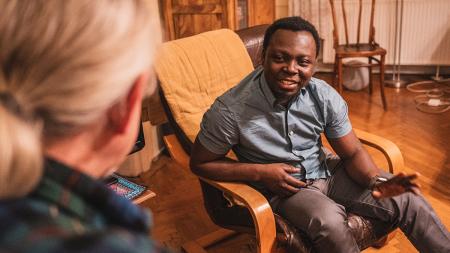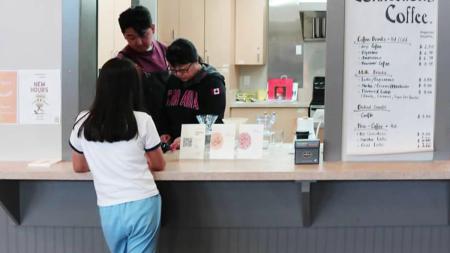Blanket Exercise Stirs Reflection

About 20 people recently took part in the Blanket Exercise, an interactive tool to help tell the story of Indigenous people in the United States, as part of the Faith and International Development Conference at Calvin College.
Participants were students and professors from different colleges around the United States and some people who work for different non-profits that were there for the conference.
There were also three people from Indigenous tribes around Grand Rapids.
The three Indigenous people shared their families' history as it related to the events, particularly the loss of their land and culture, described in the Blanket Exercise.
"It was very powerful to hear firsthand about their experience and they were very honest and open about it," says Paola Fuentes, policy analyst and advocacy fellow for the CRC's Office of Social Justice which put on the exercise.
"I was so grateful that the exercise had provided the space for them to be able to share candidly about how they and their ancestors had experienced a part of the history of the United States that we don't often learn about."
The Blanket Exercise in the US was inspired by a similar exercise of Canadian focus, created by Kairos, a Canadian social justice coalition of which the CRC’s Center for Public Dialogue is a member.
Once it was available in Canada, the exercise was then adapted to the US context by the Mennonite Central Committee US, says Fuentes.
Emphasizing the shared history of Indigenous and non-Indigenous peoples in the United States, the exercise begins with blankets arranged on the floor to represent the United States before the arrival of Europeans. The participants, who represent Indigenous people, begin by moving around on the blankets.
While narrators read a prepared script, other participants — the Europeans — join and begin to interact with those on the blankets.
As the script traces the relationship between Europeans and Indigenous nations in the United States, the participants respond to various cues and interact by reading prepared scrolls.
At the end of the exercise, only a few people remain on the blankets which have been folded into small bundles and cover only a fraction of their original area. Participants, if only for a short time, have a chance to live out a history in which the Indigenous people in the United States lost the bulk of their land.
"This is history from a perspective not often heard and it speaks to the profound urgency of reconciliation," says Fuentes.
At the end of the exercise, participants had the opportunity to reflect and share about their experience.
Fuentes says she was struck by the comment of one girl who said that the United States does not have a culture of remembering all of the parts of its history.
Other people commented, says Fuentes, that they were shocked and saddened by the fact that, even though many of them came from places where historically many Indigenous peoples had lived, they had never heard that part of the history of their hometowns.
One of the Indigenous people present also spoke, encouraging participants to develop relationships with the Indigenous people around their areas and to keep learning about this shared history, says Fuentes.
Rev. Shannon Jammal-Hollemans, who helped to coordinate the event, says a comment that struck her came from man who had not known what to expect from the Blanket Exercise.
Jammal-Hollemans is Collaborative Program Developer Discipleship & Faith Formation Ministries, and the Office of Social Justice.
She says the man told other participants that the exercise brought back a recent experience.
"Last year there was a disagreement at my church where one group of people did something that hurt another group of people. I was talking with one of the women in the group that had hurt the other group," the man said.
"I was explaining to her how the people in the other group experienced her group's actions, and she responded by saying, 'I can't believe that, because if I believe that, then I would feel horrible, and I would have to do something about it.'" He continued, "Tonight, I know how she felt."


